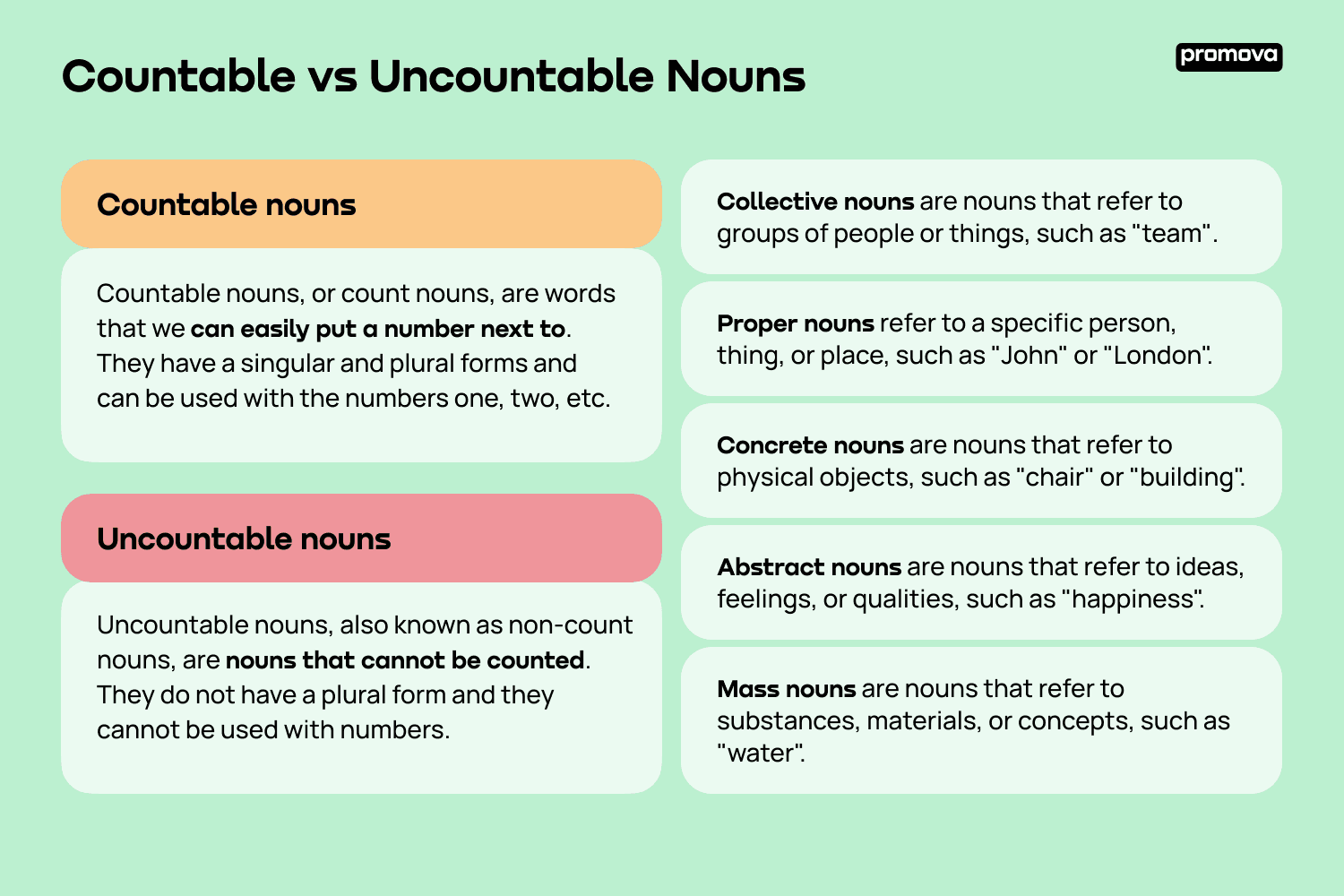Countable and Uncountable Nouns in English
Contents
Are you looking to understand nouns in English and learn to use them properly? You’ve come to the right place. In this reference, we will explore the differences between countable and uncountable nouns, explore common examples, and even how to make uncountable nouns countable!
Countable vs Uncountable Nouns
The difference between countable and uncountable nouns lies in their ability to be counted. Countable nouns, or count nouns, are words that we can easily put a number next to. They have a singular and plural forms and can be used with the numbers one, two, etc.
On the other hand, uncountable nouns, also known as non-count nouns, are nouns that cannot be counted. They do not have a plural form and they cannot be used with numbers.
For example, the word 'apple' is a countable noun. You can say "I have one apple" or "I have two apples". The word 'information' is an uncountable noun. You cannot say "I have one information" or "I have two informations".
Countable and uncountable nouns are further classified into collective nouns, proper nouns, concrete nouns, abstract nouns, and mass nouns.
- Collective nouns are nouns that refer to groups of people or things, such as "team" or "family".
- Proper nouns refer to a specific person, thing, or place, such as "John" or "London".
- Concrete nouns are nouns that refer to physical objects, such as "chair" or "building".
- Abstract nouns are nouns that refer to ideas, feelings, or qualities, such as "happiness" or "honesty".
Mass nouns are nouns that refer to substances, materials, or concepts, such as "water" or "knowledge". 
Common Countable and Uncountable Nouns
Now that you understand the difference between countable and uncountable nouns, let’s take a look at some common examples.
Common countable nouns include "person", "book", "pen", "dog", "cat", "flower", and "car". Common uncountable nouns include "water", "air", "information", "money", "advice", "energy", and "love".
It is important to note that some nouns can be both countable and uncountable. For example, the word "bread" can be countable ("I have two slices of bread") or uncountable ("I have some bread").
Context is key when determining whether a noun is countable or uncountable. If you are unsure, consult a dictionary for clarification.
7
Making Uncountable Countable
Now that you understand differences between countable and uncountable nouns, let’s take a look at how you can make uncountable nouns countable.
One way to make an uncountable noun countable is to add a word that is used for counting. For example, you can add "piece" or "slice" to "bread" to make it countable ("I have two pieces of bread"). You can also add "cup" or "bottle" to "water" to make it countable ("I have two bottles of water").
Another way to make an uncountable noun countable is to add a measurement word. For example, you can add "gram" or "pound" to "sugar" to make it countable ("I have two pounds of sugar"). You can also add "mile" or "hour" to "distance" to make it countable ("I have two miles of distance").
Here are some more useful words for you to use:
- Counting words: piece, slice, cup, bottle, box, bag
- Measurement words: gram, pound, ounce, mile, hour
Common Mistakes with Noun Count
One of the most common mistakes is using a plural verb with an uncountable noun. For example, "information" is an uncountable noun and it should be used with a singular verb, such as "The information is useful".
Another common mistake is using "many" with an uncountable noun. For example, "happiness" is an uncountable noun and it should not be used with "many", such as "I have many happiness". Instead, you should say "I have a lot of happiness".
Finally, be aware that some nouns can be both countable and uncountable. For example, the noun "time" can be used as both countable and uncountable. If you are talking about a specific amount of time, it is countable ("I have two hours of time"), but if you are talking about an indefinite amount of time, it is uncountable ("I have a lot of time").
Summary
We explored the difference between countable and uncountable nouns, common countable and uncountable nouns, how to make uncountable nouns countable, and common mistakes with noun count, and provided many helpful tips to help you understand the concept. Now, it's time to practice and work with your own countable and uncountable nouns!



Comments